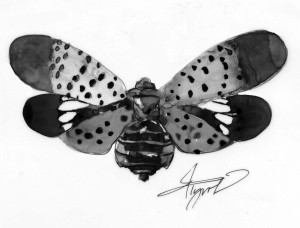
In September 2021, one boy’s blue ribbon-winning 4H project at the Kansas State Fair made national news. The exhibit included a colorfully-spotted, inch-long, moth-like insect that immediately attracted the attention of entomologists. The insect, which the boy had found on his front porch, was a spotted lanternfly (Lycorma delicatula). Native to Asia, this species was discovered in Berks County, Pennsylvania, in 2014 and is considered a harmful invasive in the United States, causing much stress to plants, gardeners, foresters, and farmers. Although it is firmly established in the northeastern United States, the 4H exhibit was the first time entomologists had noted the spotted lanternfly’s existence so far west.
Spotted lanternflies belong in the mostly tropical family Fulgoridae. The common name comes from a false belief that a projection from the heads of many species glowed in the dark, a myth propagated through the European scientific literature during the 1700s.
The insects hatch from eggs between April and June and develop through four nymphal instars. The nymphs have stubby black bodies with white spots and long legs. When I tried to snag a few for a closer look during a visit near Philadelphia, I learned that they are fast movers, and I had little hope of success without a net. The adults are found between mid-July and fall’s first frost. I found many deceased lanternflies available for examination.
The spotted lanternfly’s preferred host is the tree of heaven (Ailanthus altissima), another aggressive invasive species. But spotted lanternflies will also nibble on the tender parts of more than 170 plant species, including hops, apples, grapes, walnuts, and a range of hardwood trees that lack defenses to deal with Asian insects.
Like other hemipterans or true bugs, lanternflies have piercing mouth parts. Lanternflies use their sharp drinking straw-like apparatus to tap the stems and branches of their hosts for sugary sap. While extracting plant nutrients directly weakens plants, it is just the beginning of several steps that cause plant illness and death. Like the rest of us, lanternflies need nitrogen to make proteins. But plant sap is mostly water, with some sugar in the mix; nitrogen is far down the list on the nutrition facts label. To accumulate enough nitrogen for growth, sap feeders must ditch all of that water and sugar as a waste product called “honeydew.”
Ants take advantage of this waste and “farm” honeydew from aphids to get a high-calorie supplement to their diet. Lanternflies, however, lack devoted ant followers, so honeydew accumulates on plant stems, rendering the bark a sticky mess. Just as human-derived waste causes algal blooms, lanternfly waste causes a bloom of a different kind: mold. Spores from molds that otherwise might not infest a particular plant stick to and then propagate molds that are both unsightly and injurious to many plants.
Preventing the spread of this invasive species is a particularly difficult, because lanternflies are indiscriminate egg-layers. While many insects deposit eggs only on the perfect larval food source, some insects with broad host ranges lay eggs on nearly any plant. Lanternflies take this to the next level. They will lay eggs on nearly anything standing still. This includes bridges, homes, and – most worryingly – vehicles and trailers, where eggs can be unwittingly moved from place to place.
Early Pennsylvania distribution maps showed spread from Berks County to adjacent counties, straight west along the Pennsylvania Turnpike route, and north along the Northeastern Turnpike Extension. More recent maps show expansion from these initial Pennsylvania counties into bordering states of Delaware, Maryland, New Jersey, New York, Ohio, Virginia, and West Virginia, and as far afield as Indiana and Massachusetts. Isolated individuals have been found in locations including Rutland, Vermont – and the Kansas State Fair.
Scientists believe spotted lanternflies could survive as far north as southern New Hampshire, southern coastal Maine, and through warmer portions of the Champlain Valley into Vermont and Upstate New York. Discovery of spotted lanternflies – or other invasive species – in Vermont should be reported to vtinvasives.org and in New Hampshire to nhbugs.org.


Discussion *